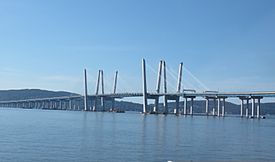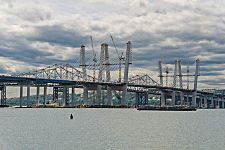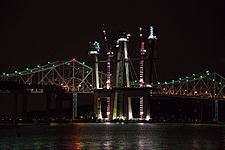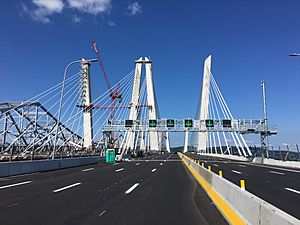Tappan Zee Bridge (2017–present) facts for kids
Quick facts for kids Governor Mario M. Cuomo Bridge(Tappan Zee Bridge) |
|
|---|---|

The bridge in 2019
|
|
| Coordinates | 41°04′17″N 73°53′28″W / 41.07139°N 73.89111°W |
| Carries | 8 automobile lanes, 2 bus lanes, 2 bicycle/pedestrian lanes |
| Crosses | Hudson River |
| Locale | Connecting Nyack (Rockland County) and Tarrytown (Westchester County) |
| Official name | Governor Mario M. Cuomo Bridge |
| Other name(s) | Cuomo Bridge; New NY Bridge; New Tappan Zee Bridge |
| Maintained by | New York State Thruway Authority |
| Characteristics | |
| Design | dual-span cable-stayed twin bridge |
| Total length | 16,368 ft (4,989.0 m; 3.1 mi; 5.0 km) |
| Width | 183 ft (56 m), total of both decks: 87 ft (27 m) and 96 ft (29 m) |
| Height | 419 ft (128 m) |
| Longest span | 1,200 ft (370 m) |
| Clearance above | unlimited |
| Clearance below | 139 ft (42 m) |
| History | |
| Construction begin | 2013 |
| Construction cost | $3.9 billion (2013 project budget) |
| Replaces | Tappan Zee Bridge (1955–2017) |
| Statistics | |
| Toll | Cars $6.83 Tolls-by-Mail; $5.75 NY E-ZPass (eastbound/southbound only) Larger vehicles pay variable toll based on vehicle class and time of day (cashless toll) |
The Governor Mario M. Cuomo Bridge, often called the Tappan Zee Bridge, is a large cable-stayed bridge that crosses the Hudson River. It connects the towns of Tarrytown and Nyack in New York State. This bridge is actually two separate bridges built side-by-side.
It was built to replace an older bridge, the original Tappan Zee Bridge, which was located just south of the new one. The north bridge carries traffic heading north and west, including I-87 and I-287. It also has a special path for bikes and walkers. The south bridge carries traffic heading south and east.
Work to replace the old bridge started in 2012, and construction began in 2013. A giant crane called the Left Coast Lifter helped build the bridge. The north bridge opened for westbound traffic on August 26, 2017. Eastbound traffic used this same bridge for a short time starting October 6, 2017. The old bridge was then taken down. The south bridge opened on September 11, 2018.
The bridge is officially named after former New York Governor Mario Cuomo. However, this name has caused some debate among local residents.
Contents
History of the Tappan Zee Bridge
Why a New Bridge Was Needed
The name "Tappan Zee" comes from 17th-century Dutch settlers. "Tappan" was the name of a Native American tribe, and "Zee" means "sea" in Dutch. The Tappan Zee Bridge and the smaller Bear Mountain Bridge are the only ways to cross the Hudson River between Westchester and Rockland counties.
The original Tappan Zee Bridge was built between 1952 and 1955. It was about 3 miles (4.8 km) long and was the longest bridge in New York State at the time. It was built quickly after the Korean War with a budget of $81 million. It was designed to last only 50 years. When it first opened, fewer than 40,000 cars used it each day.
By the 2000s, the old bridge was getting old and carrying too much traffic. About 140,000 vehicles crossed it daily, much more than it was built for. In 2007, a bridge in Minnesota collapsed, which made people worry even more about the Tappan Zee Bridge's safety. Because of these worries, along with heavy traffic and high repair costs, people started seriously talking about building a new bridge or a tunnel.
Planning the New Bridge
In October 2011, it was decided that the Tappan Zee Bridge would be replaced by two new bridges, built side-by-side. The new bridge would be built a few yards north of the old one. It would connect to the existing highways on both sides of the river.
Several companies offered plans to build the bridge. The contract was given to Tappan Zee Constructors (TZC) for $3.142 billion. Their plan was the cheapest and promised to build the bridge the fastest, while also protecting the environment. Construction started in October 2013, aiming to finish by 2017.
There was some worry that the tolls (the money you pay to cross the bridge) might become very expensive. However, the state decided to keep the toll at $5 until 2020. The new bridge was designed to have four lanes for vehicles on each side, making a total of eight lanes. It also included a path for bikes and walkers. The New York State Thruway Authority manages the bridge, just like the old one.
Building the Bridge
The project was approved for federal funding in August 2012. The approval process was very fast, taking less than a year. This was because the project was put on a "fast track" by the government. The $3.14 billion project was paid for through a mix of public and private money.
Tappan Zee Constructors, a group of design and construction companies, built the new bridge. The huge Left Coast Lifter crane helped put large parts of the bridge into place. Before construction, General Electric spent four seasons cleaning up the river bottom, removing a lot of dirt and pollution.
During construction, on July 19, 2016, a crane used for the bridge collapsed onto the old bridge. Five people were hurt, but thankfully no one was seriously injured or killed.
Finishing the Project
The new northbound/westbound bridge opened on August 26, 2017. Southbound/eastbound traffic continued to use the old bridge until October 6, 2017. Then, this traffic also moved to the new northbound/westbound bridge temporarily. This allowed workers to finish building the new southbound/eastbound bridge.
The project was expected to be finished by June 2018, costing about $3.98 billion. However, there were some delays. The new southbound/eastbound bridge was supposed to open on September 8, 2018. An opening ceremony was held, but the traffic shift was delayed because a piece of the old bridge came loose during demolition. After the old bridge was made safe, all lanes of the new bridge opened on September 11, 2018.
Once finished, the new Tappan Zee Bridge became one of the widest cable-stayed bridges in the world. It is built to last at least 100 years.
Taking down the old bridge began in November 2017. Large sections of steel were removed. In May 2018, the 10-million-pound main part of the old bridge was taken away. The original plan was to remove the rest of the old bridge piece by piece. However, because of the instability of one section in September 2018, it was decided to use explosives to bring it down. This happened on January 15, 2019. The last part of the western approach was removed on May 12, 2019.
Tolls for Crossing
The Tappan Zee Bridge only charges tolls when you are driving in the southbound/eastbound direction. On weekdays, the cost changes depending on the type of vehicle and the time of day. The tolls are collected using a cashless toll system, meaning there are no toll booths where you stop to pay.
If you use an E-ZPass, you pay the lowest rate. Other drivers pay a higher rate. For example, a regular car (Class 2L) pays $6.83 without an E-ZPass, or $5.25 with a New York-issued E-ZPass.
Path for Bikes and Walkers
On June 15, 2020, a special path for bikes and walkers opened on the northern side of the bridge. This path connects Tarrytown and South Nyack. The path is 3.6 miles (5.8 km) long.
There are visitor centers at each end of the path, named after Rockland and Westchester counties. Both centers have restrooms, information, and interactive displays. The Westchester center also has food and drink vendors. The path has two lanes: one for bikes and one for walkers.
Along the path, there are six scenic spots called "belvederes." Each belvedere is named after a local landmark and offers Wi-Fi, places to sit, bike racks, information kiosks, and trash cans. The path also has LED screens that show warning messages.
Bridge Lighting
The bridge uses LED lights for its roadways and structure. These lights can change to many different colors. This allows the bridge to be lit up in special ways for holidays like Memorial Day and Christmas, or for other important dates and events throughout the year. The lighting system can even be synced to music, though this has not been shown yet.
Public Transportation
The Hudson Link bus service uses the bridge for several routes. During the summer, Hudson Link also offers free shuttle buses. To help with traffic, the bridge was built with one special "express bus lane" in each direction for use during busy times. These bus lanes were finished in 2020. The bridge was also designed so that it could be expanded to include commuter rail in the future. The Tarrytown train station is about 2,000 feet (610 m) from the bridge's eastern side.
Naming the Bridge
During its construction, the bridge was often called the "New NY Bridge" or the "New Tappan Zee Bridge."
In 2017, Governor Andrew Cuomo successfully passed a law to name the bridge after his father, former Governor Mario Cuomo. However, many people living nearby did not agree with this name change. They felt the bridge should keep the name "Tappan Zee Bridge" because it is part of their local history. Even the daughter of former Governor Malcolm Wilson, who the old bridge was named after, spoke out against the change.
A survey showed that only a small number of local residents supported the new name. Many people signed an online petition asking to change the name back to "The Tappan Zee." Even with the official name, many people still call it the "Tappan Zee Bridge."
In December 2017, a state assemblyman tried to pass a law to change the name back to "Malcolm Wilson Tappan Zee Bridge." A compromise idea was to name it the "Governor Mario M. Cuomo Tappan Zee Bridge." The State Senate voted for this idea, but it did not become law because the Assembly did not vote on it.
See also
 In Spanish: Tappan Zee Bridge (2017) para niños
In Spanish: Tappan Zee Bridge (2017) para niños





